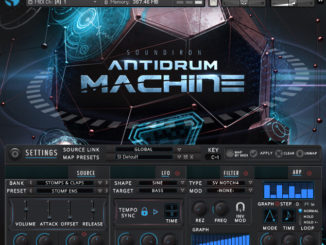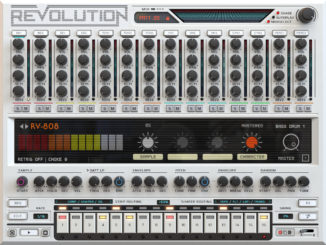UVI PX WaveFrame is a new sample-based virtual instrument that brings the sounds of the WaveFrame AudioFrame digital sampler from the 1980s to your DAW – review
When discussing samplers today, we think of hardware (Elektron Digitakt, Octatrack, Roland SP-404) or software (NI Kontakt 8, UVI Falcon, a DAW…) However, sampling has a long history. One of the first devices that made digital sampling possible was the very rare WaveFrame AudioFrame.
It was a digital audio workstation (DAW) with a sampler, hard disk recorder, and digital mixer. UVI’s sound designer team revived the sounds of this retro device in the new PX WaveFrame virtual instrument, which is the successor to the initial WaveFrame library.
UVI PX WaveFrame
Installing the PX WaveFrame virtual instrument is easy, but downloading it takes time. At 10.14 GB, it is not a small instrument. You need the UVI Portal desktop app and iLok software. Even though I prefer any software release without iLok chains, I had no problems since the software version. Not here either.
Once downloaded, the UVI PX WaveFrame instrument can be experienced in two ways: in the flagship synth UVI Falcon 3, as in my case, or the free UVI Workstation plugin.
When you open it, you are greeted by a lovely, retro computer GUI that takes you back to the 1980s. It has five taps: main, edit, mod, FX, and arpeggiator.
PX WaveFrame is a dual-layer instrument with independent sound selection and controls for each layer. Important: it’s not an emulation of the retro WaveFrame sampler engine.
Main
On the main page, you can set the sound source for each layer using a drop-down menu. You can find here a large selection of multi-sampled sound sources: keyboards, guitars, basses, solo strings, brasses, woodwinds, mallets, raw waveforms, and more.
The sounds were multi-sampled raw from the WaveFrame AudioFrame hardware. An SFX mode offers an alternative version of the selected sample that has been processed to meet today’s sound standards. So, you can flip between super retro and more “modern retro” – a neat option. In addition, each layer offers volume and pan control.
PX WaveFrame has two independent layers, each with a multimode filter and two dedicated ADSR envelopes (filter and amp). Settings can be set for each layer individually or both simultaneously. The filter has cutoff and resonance controls and four options: OFF, lowpass, bandpass, and highpass. From the sound design perspective, the option to ignore the filter is welcome.
Edit
Like on the main page, you can apply the parameters on the edit page per layer or in dual-layer mode. “Edit” sounds like a lot of sound design fun here, but it features very basic controls.
You can set the voicing (poly/mono), the instrument’s pitch, and a stereo mode with various modes (unison, alternate) and a few parameters. Below, you can route three controls to the mod wheel: vibrato, tremolo, and filter. Yes, again, per layer or both at the same time. This allows you to play each layer differently with the mod wheel.
It’s a shame that you can’t freely choose which parameter you want to route to the mod wheel. This is a bit too limited.
Modulation (Mod)
Modulation can be found on the mod page. It hosts a step modulator and a multimode LFO. The step modulator has 16 steps, including speed control, delay, rise, and smoothing. The amplifier and the filter of each layer can be controlled with it. A bit weak to me. Same for the LFO.
UVI PX WaveFrame offers a single multi-wave sync-able low-frequency oscillator with a retrigger and legato option. You can modulate each layer’s amp level, pitch, and filter. If you route the signal to both layers, you can modulate up to six parameters simultaneously.
This is more than enough to bring movement into the sounds. But suppose you want to generate complex modulations or animate more parameters. In that case, you will quickly reach your limits here unless you have UVI Falcon 3, where you have full access to the parameters.
Effects
PX WaveFrame has a multi-FX processor with an EQ, drive, Thorus (chorus), ensemble FX, phasor, delay, and reverb to refine or finalize your sounds. These are high quality and based on the effects of the UVI Falcon 3 flagship synth. A small minus point goes to the missing global FX on/off switch.
Arpeggiator
Further, the new PX WaveFrame virtual instrument hosts a 16-step arpeggiator with three playback directions for each layer. The arpeggiator can run independently or in link mode and sequence independent notes or chords.
It lets you set the velocity, tie, note/chord mode, semi-tone, pan, gate, and CC (CC 1) per step. This gives you much flexibility, from simple arpeggiators to complex sequencer-like melodies.
Sounds
UVI PX WaveFrame is a colorful, versatile virtual instrument for macOS and Windows. You can find acoustic sounds like guitars, orchestral sounds such as flutes, violins, and choirs, and bread-and-butter synthetic sounds such as synth bass, leads, pads, and more.
It has 351 presets and 151 layers (sound sources). Each is high quality and can be combined with other sounds as desired. You get here a very retro, cheesy-sounding virtual instrument that will immediately make you feel nostalgic.
An overview of the patches can be found in the linked sound demo. Synth Anatomy Patreon supporters ($1/per month +) get another 10 minutes + extra sounds.
UVI PX WaveFrame Review
UVI PX WaveFrame is not a powerful virtual instrument or isn’t at a flagship synth level. Not at all. However, it is a very focused virtual instrument that puts the sounds of the retro AudioFrame WaveFrame DAW + sampler into the DAW.
The included patches are delightful, motivating, and pleasing to the ear. They evoke the charm of vintage rompler sounds for me. If that isn’t sufficient, you can effortlessly craft your own sounds using the Falcon-powered engine.
It’s disappointing that the modulation engine has some limitations regarding destinations. Additionally, there’s no global FX on/off switch, and users lack unrestricted access to the raw samples. Overall, the UVI PX WaveFrame virtual instrument offers a lovely retro vibe that enthusiasts of such sounds will appreciate.
UVI PX WaveFrame is available now for 79€ and runs as a 64-bit VST, VST3, AU, and AAX plugin on macOS (native Apple Silicon + Intel) and Windows. It requires UVI Falcon 3 or the free UVI Player, and you also need an iLok account (software or hardware dongle).
More information here: UVI










As you mentioned, the “WaveFrame Sound Collection” was offered already by UVI, in 2021? I recall but cannot confirm, that original developer Michael Bard may have been involved. It has a nice, modern-looking GUI, not the retro/Mac one shown here. Their original soundbank was much smaller, also – 370Mb, per the product manual. It was/is…okay?:) Not wildly interesting as a reissue, but of historical significance, to be sure. Probably more fun with the retro interface, but it would be nice if UVI offered this at a discount to owners of the initial of the initial offering. Does UVI have any statement as to why this is better, other than the retro Mac view and sample size?
In 2020. No I don’t think the original developer is invovled in this because it’s not an emulation but a multi-samples based instrument. I don’t see any info about an upgrade but now in the UVI holiday sale, you can get it for 59€. I prefer this modern view as its more intuitive to me. The higher sample size is due to the multi-sample nature. Each patch already has the option to choose between the raw and processed sample sets which sums up in the GBs 🙂
Its a crime that you dont also feature a photo of an actual WaveFrame AudioFrame! Follow my website link for a 1989 Sound On Sound article on this magnificent beast!
it’s a crime lol